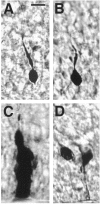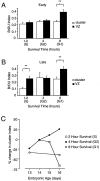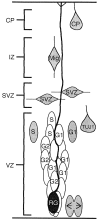Cell coupling and uncoupling in the ventricular zone of developing neocortex
- PMID: 9278539
- PMCID: PMC6573271
- DOI: 10.1523/JNEUROSCI.17-18-07037.1997
Cell coupling and uncoupling in the ventricular zone of developing neocortex
Abstract
Cells within the ventricular zone (VZ) of developing neocortex are coupled together into clusters by gap junction channels. The specific role of clustering in cortical neurogenesis is unknown; however, clustering provides a means for spatially restricted local interactions between subsets of precursors and other cells within the VZ. In the present study, we have used a combination of 5-bromo-2'-deoxyuridine (BrDU) pulse labeling, intracellular biocytin labeling, and immunocytochemistry to determine when in the cell cycle VZ cells couple and uncouple from clusters and to determine what cell types within the VZ are coupled to clusters. Our results indicate that clusters contain radial glia and neural precursors but do not contain differentiating or migrating neurons. In early neurogenesis, all precursors in S and G2 phases of the cell cycle are coupled, and approximately half of the cells in G1 are coupled. In late neurogenesis, however, over half of the cells in both G1 and S phases are not coupled to VZ clusters, whereas all cells in G2 are coupled to clusters. Increased uncoupling in S phase during late neurogenesis may contribute to the greater percentage of VZ cells exiting the cell cycle at this time. Consistent with this hypothesis, we found that pharmacologically uncoupling VZ cells with octanol decreases the percentage of VZ cells that enter S phase. These results demonstrate that cell clustering in the VZ is restricted to neural precursors and radial glia, is dynamic through the cell cycle, and may play a role in regulating neurogenesis.
Figures






References
-
- Alvarez-Buylla A, Buskirk D, Nottebohm F. Monoclonal antibody reveals radial glia in adult avian brain. J Comp Neurol. 1987;264:159–170. - PubMed
-
- Antonopoulos J, Pappas I, Parnavelas J. Activation of the GABAA receptor inhibits the proliferative effects of bFGF in cortical progenitor cells. Eur J Neurosci. 1997;9:291–298. - PubMed
-
- Blanton M, LoTurco J, Kriegstein A. Whole cell recording from neuron in slices of reptilian and mammalian cerebral cortex. J Neurosci Methods. 1989;30:203–210. - PubMed
-
- Boulder Committee. Embryonic vertebrate central nervous system: revised terminology. Anat Rec. 1970;166:257–261. - PubMed
Publication types
MeSH terms
Substances
Grants and funding
LinkOut - more resources
Full Text Sources
Miscellaneous
